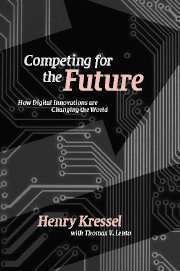Book contents
- Frontmatter
- Contents
- List of figures
- List of tables
- Acknowledgements
- Introduction
- Part I The technology – how electronic devices work – digital systems and software
- Part II Innovators, entrepreneurs, and venture capitalists
- Part III Global reach, global repercussions
- Appendix 1.1 Smaller, faster, more efficient MOSFETs
- Appendix 1.2 Building multi-transistor logic gates
- Appendix 1.3 MOSFETs in memory devices
- Appendix 1.4 CMOS reduces logic gate power dissipation
- Appendix 1.5 Laser diode basics
- Appendix 1.6 Light-emitting diodes (LEDs)
- Appendix 1.7 Photodetectors
- Appendix 1.8 Making fiber optic cables
- Appendix 1.9 Principles of LCD displays
- Appendix 2.1 The demise of analog computers
- Appendix 2.2 IP, TCP, and the Internet
- Appendix 2.3 Building an object-oriented program
- Index
Appendix 1.7 - Photodetectors
Published online by Cambridge University Press: 07 December 2009
- Frontmatter
- Contents
- List of figures
- List of tables
- Acknowledgements
- Introduction
- Part I The technology – how electronic devices work – digital systems and software
- Part II Innovators, entrepreneurs, and venture capitalists
- Part III Global reach, global repercussions
- Appendix 1.1 Smaller, faster, more efficient MOSFETs
- Appendix 1.2 Building multi-transistor logic gates
- Appendix 1.3 MOSFETs in memory devices
- Appendix 1.4 CMOS reduces logic gate power dissipation
- Appendix 1.5 Laser diode basics
- Appendix 1.6 Light-emitting diodes (LEDs)
- Appendix 1.7 Photodetectors
- Appendix 1.8 Making fiber optic cables
- Appendix 1.9 Principles of LCD displays
- Appendix 2.1 The demise of analog computers
- Appendix 2.2 IP, TCP, and the Internet
- Appendix 2.3 Building an object-oriented program
- Index
Summary
Semiconductor devices for sensing light levels are in wide use, and their properties are tailored to specific applications. They range in complexity from the simplest light sensors, used in door openers, to sophisticated devices that detect ultra-short, very low-level communications signals that have traveled hundreds of miles over an optical fiber.
As mentioned in the main text, light sensors are also the core sensing element in imaging devices, where millions of sensors are built into a single chip. Finally, solar energy converters (solar cells) are in the same class of device.
We learned in Chapter 2 that a photodetector is usually a reverse-biased p-n junction. The type of semiconductor material used for the junction is determined by its intended application, particularly with regard to the wavelength of the light to be detected and the response speed desired.
The operational principle is that a photon of incident light absorbed in the vicinity of the p-n junction, and within the depletion zone, generates free carriers that give rise to a current proportional to the intensity of the incident light. Figure A-1.7.1 shows the p-n junction detector in the dark and with incident light. The current through the device increases with light intensity.
Silicon photodetectors are widely used to capture visible light, whereas III-V compound devices are used to detect signals in the infrared portion of the spectrum.
- Type
- Chapter
- Information
- Competing for the FutureHow Digital Innovations are Changing the World, pp. 370 - 371Publisher: Cambridge University PressPrint publication year: 2007



